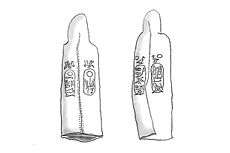Amenemnisu
| Amenemnisu | |
|---|---|
|
Drawing of the bowcaps containing both Amenemnisu and Psusennes' names | |
| Pharaoh | |
| Reign | 1051–1047 BCE (21st Dynasty) |
| Predecessor | Smendes |
| Successor | Psusennes I |
|
| |
| Died | 1047 BCE |
Neferkare Amenemnisu was an ancient Egyptian pharaoh of the 21st Dynasty.
Reign
Amenemnisu's existence was only confirmed in 1940 when the Tanite tomb of his successor Psusennes I was discovered by Pierre Montet: a gold bow cap inscribed with both Amenemnisu's royal name, Neferkare, and that of his successor Psusennes I was found within the tomb.[1] Previously, his existence had been doubted as no objects naming him had been discovered. However, the memory of his short rule as the second pharaoh of the 21st Dynasty was preserved in Manetho's Epitome as a king Nephercheres who is assigned a short reign of 4 years.[2]
While his reign is generally obscure, the then High Priest of Amun at Thebes, Menkheperre, is known to have pardoned several leaders of a rebellion against the High Priest's authority during Amenemnisu's reign.[1] These rebels had previously been exiled to the Western Oasis of Egypt in Year 25 of Smendes. These events are reported on the so-called Banishment Stela (Louvre C. 256), likely made during the brief reign of Amenemnisu.[3]
References
| Wikimedia Commons has media related to Amenemnisu. |
- 1 2 K.A. Kitchen, The Third Intermediate Period in Egypt (c. 1100-650 BC), Warminster, 3rd ed. 1996. § 218.
- ↑ Peter Clayton, Chronicle of the Pharaohs, Thames & Hudson Ltd., 1994. p. 178
- ↑ K.A. Kitchen, 1996, §§ 213; 218
